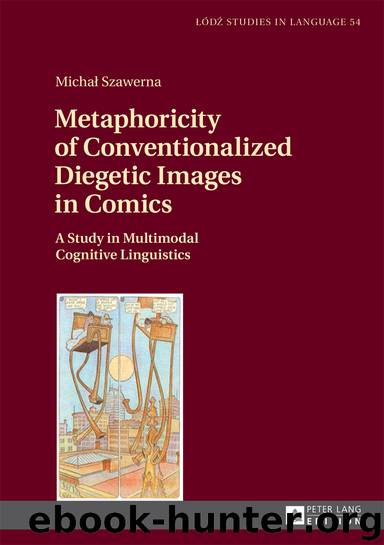Metaphoricity of Conventionalized Diegetic Images in Comics by Michal Szawerna

Author:Michal Szawerna
Language: eng
Format: epub
Publisher: Peter Lang AG
Published: 2017-06-23T00:00:00+00:00
| 251 →
Chapter 4. Metaphoricity of conventional representations of diegetic sound in comics
4.0. Introduction
In this, the third analytical chapter of my study of the metaphorical underpinnings of major visual conventions belonging to the narrative medium of comics, I will examine the general semiotic makeup and then further explore the metaphoricity of primary conventional representations of diegetic sound events, that is, sound events occurring in diegetic worlds represented in comics exemplifying various publication formats, generic conventions, and cultural traditions. Specifically, the representational conventions subsumed into the analytical scope of this chapter include (1) complex static planar objects referred to metaphorically as balloons, which typically consist of three components: a discrete pictorial container, a linear projection connecting this container to a pictorial image representing the source of the sound visualized in balloonic form, and the contents encapsulated by the balloonic container, which may in turn take the form of quasi-pictorial images (specifically, pictograms), non-pictorial images (specifically, writing or stand-alone punctuation marks), or a combination of these, and (2) stand-alone written text. In the narrative medium of comics, these representational conventions are deployed on a regular basis as visual signs of the audible form of speech events, non-speech vocalizations produced with the use of the speech apparatus, and various environmental sounds.
I have established the status of these representational conventions as primary means of visualizing diegetic sound in the narrative medium of comics on the basis of two facts. Firstly, it is these conventions in particular that are discussed in considerable detail by the major representatives of the new comics scholarship who explored the topic of how diegetic sound is depicted in comics: Eisner (2008 /1985/), McCloud (1994 /1993/), Groensteen (2007 [1999]), Duncan and Smith (2009), Cohn (2007, 2013b), and Forceville, Veale, and Feyaerts (2010). Secondly, unlike many highly ambiguous visual signs belonging to the narrative medium of comics, which may be used to depict a variety of diegetic entities depending on the need at hand, balloons and stand-alone written texts are almost invariably deployed by creators of comics as means of visualizing diegetic sound events, even though they may simultaneously represent aspects of aurally communicated meaning — especially when they are deployed as representations of diegetic speech events. The only exception to the principle whereby balloons and stand-alone written texts represent diegetic sound events pertains to the use of these static planar signs as representations of direct thought formed in the minds of sentient characters. I will discuss balloonic and stand-alone representations in their capacity as visual signs of meanings communicated by means of diegetic sounds and as visual signs of diegetic thought in the ← 251 | 252 → following chapter, in which I will anatomize the conventions deployed by creators of comics to visualize the psychological experience of sentient individuals.
The objectives of this chapter are analogous to the goals set in the two preceding analytical chapters. Specifically, the main goal of this chapter is to contribute to multimodal cognitive linguistics in general, and to the intersection of conceptual metaphor theory and
Download
This site does not store any files on its server. We only index and link to content provided by other sites. Please contact the content providers to delete copyright contents if any and email us, we'll remove relevant links or contents immediately.
Things Are What You Make of Them: Life Advice for Creatives by Adam J. Kurtz(1776)
The Monuments Men by Robert M. Edsel(1702)
The Freelance Manifesto: A Field Guide for the Modern Motion Designer by Joey Korenman(1522)
Find Your Artistic Voice by Lisa Congdon(1347)
The Business of Being an Artist by Daniel Grant(1302)
101 Gag Ideas: Companion to the One Minute Caricature by James van der Keyl(1280)
Boom by Michael Shnayerson(1252)
Your Art Will Save Your Life by Beth Pickens(1203)
Your Inner Critic Is a Big Jerk by Danielle Krysa(1196)
Breakfast at Sotheby's(1163)
The Lady in Gold by Anne-marie O'connor(1155)
Seven Days in the Art World by Sarah Thornton(1143)
Create Your Art Career by Rhonda Schaller(1139)
How to Survive and Prosper as an Artist by Caroll Michels(1114)
When Talent Isn't Enough: Business Basics for the Creatively Inclined by Kristen Fischer(1074)
33 Artists in 3 Acts by Sarah Thornton(1070)
Need you Now (Top Shelf Romance Book 2) by unknow(1038)
Art Held Hostage by John Anderson(1033)
Art of the Deal by Noah Horowitz(1031)
